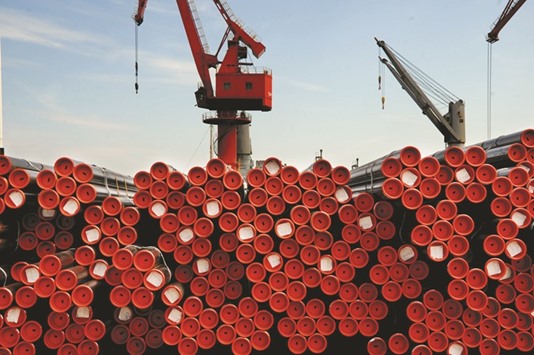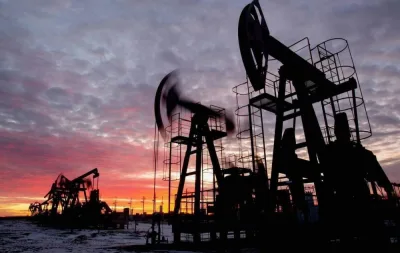China’s exports fell more than expected in May as global demand remained stubbornly weak, but imports beat forecasts, pointing to improving domestic demand and adding to hopes that the world’s second-largest economy may be slowly stabilising.
Exports fell 4.1% from a year earlier, the General Administration of Customs reported, saying the foreign trade environment remains a challenge.
Imports dropped 0.4% from a year earlier, the 19th straight month of declines but the smallest since they turned negative in November 2014.
The improvement likely reflected higher commodities prices but also a pick-up in domestic demand as Beijing hikes spending on big infrastructure projects to support growth.
China’s May crude oil imports jumped the most in over six years, with iron ore imports the highest since December and purchases of copper up more than 19%.
“Imports were better, due to a rebound in commodities prices and signs of restocking by firms,” said Liu Yaxin, an economist at Merchants Securities in Beijing. But Liu said: “We are not optimistic about the economy in the second half due to limited policy support, and the government’s push to cut (industrial) overcapacity could weigh on growth We expect the economy to grow 6.8% in the second quarter.”
Indeed, the outlook remained grim for China’s exporters.
Shipments have now fallen for 10 of the last 12 months and there are few signs that a prolonged global trade slump is abating.
China’s shipments to the United States – its top export market – fell 12% in May, while shipments to the European Union – its second biggest customer – fell 2.1%.
“We do not expect any substantial rebounds in coming months,” said Chester Liaw at Forecast PTE in Singapore.
China’s trade surplus was $49.98bn in May, versus forecasts of $58bn and April’s $45.6bn. Economists polled by Reuters had expected May exports to fall 3.6%, twice the pace seen in April, and expected imports to fall 6%, following April’s 10.9% drop.
Some analysts had speculated that upbeat March economic data was largely due to a jump in steel industry activity but thought it would taper off as domestic steel prices fell.
But data showed China’s steel exports rose 3.7% in May from April, as cash-hungry mills shipped more abroad despite growing tensions with major trading partners which are accusing Chinese firms of dumping product on glutted world markets.
Analysts said import performance could improve further later in the year as Beijing’s more than one-year-long stimulus campaign finally seems to be paying bigger dividends.
“The bigger-than-expected improvement suggests that import volumes, which have held up relatively well recently and are a better gauge of underlying demand, may also have picked up,” Julian Evans-Pritchard, China economist at Capital Economics, said in a note.
“Import growth is likely to edge up further for the remainder of this year as the fall in commodity prices during the second half of 2015 enters the base for comparison and the feed-through from earlier policy easing helps prop up domestic demand.
We expect it to return to positive before long.” There was little indication that May’s trade performance would pressure China into any near-term change in its currency policy.
“We don’t expect the trade figure will change the PBoC’s attitude towards the RMB exchange rate.
They still prefer stability,” ANZ analysts said in a note.
Chinese officials repeatedly pledged in two days of talks with their US counterparts this week that they saw no need for a sustained weakening of the yuan currency, which many investors fear could shock the already sluggish US and global economies and roil financial markets as happened in January.
Meanwhile, China’s central bank slashed its forecast for exports yesterday, predicting a second straight annual fall in shipments, but said the economy will still grow 6.8% this year.
The People’s Bank of China (PBoC) also warned in its mid-year work report that the government’s push to reduce debt levels and overcapacity could increase bond default risks and make it more difficult for companies to raise funds.
And, ahead of a meeting of the US Federal Reserve’s policymaking board next week, it said the pace of U.S interest rate rises would affect global capital flows and emerging market currencies, but it did not mention the yuan.
“Since the beginning of this year, the global and domestic economic environment has experienced a number of changes,” the PBoC said in the report.
“Reflecting these recent developments, we revised our China macroeconomic forecasts for 2016. Compared with our published forecasts in December last year, we maintain our baseline projection of 2016 real GDP growth at 6.8%.”
However, some economists cautioned that imports from Hong Kong may have once again been inflated by fake trade invoicing to disguise speculation on the yuan, which came under renewed depreciation pressure last month as the US dollar surged.
Chinese customs data showed the mainland’s imports from Hong Kong jumped 242.6% in May from a year earlier, while its exports to the territory fell 7%.

Products for shipments are placed at a port in Lianyungang, Jiangsu Province. China’s shipments to the US fell 12% in May, the General Administration of Customs reported yesterday.


